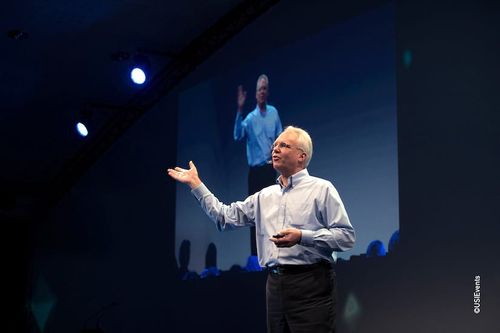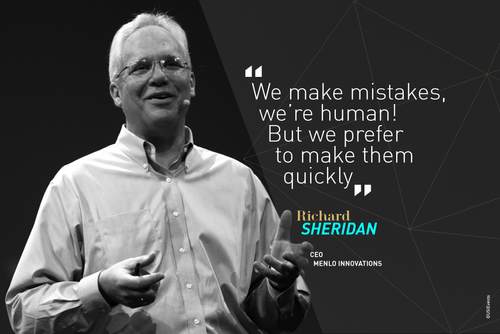8 quick-win from one of the most liberated companies in America
Richard Sheridan is the CEO of Menlo Innovation and author of Joy Inc. He presents the keys to one of the most liberated companies in America. Tips, rules and experiments are at the heart of this vibrant feedback full of examples, where everyone can take out at least one quick-win to implement at work.
Why talk about a culture of "joy"?
Writing a book on business with the words “joy” and “love” on the cover is surprising. Why talk about joy? Richard Sheridan is an excellent storyteller – in fact that’s the title that features on his business card. He links the start of his passion to a childhood memory, the time when he secretly built a piece of furniture for his parents’ sitting room and gave immense joy and pleasure to his mother, which made him proud.
“Joy comes from helping others, from our ability to create wonder for others through what we do”, according to Sheridan.
But this childhood joy was soon replaced with fear and disillusionment that prevail in the software industry, between chaos, burocracy and projects that never come to fruition. Sheridan asks the room to imagine how disappointed the Microsoft teams who launched Windows Vista must have been when, after five years of hard work, they saw the result of their work dead and buried just after its launch. At the start of the years 2000, Sheridan’s career was rapidly growing, yet he felt as though he were dying. A book called Extreme programming explained, which describes a radically different way of organizing an engineering team, as well as a video of a small Californian design company at the time called Ideo, made him think. Thus, rather than flee from this sector, he decided to find better ways of organizing it.
Read : Our interview with Richard Sheridan "What you want as an ingeneer is to delight"
The keys of Menlo's culture
Sheridan then shows a video of Menlo, which shows the office of this “paradise at work”. The office is far from glitzy compared to other innovation companies. What is striking is the lack of walls. Many articles have tried to demonstrate that open spaces were inefficient or even toxic for work, but Sheridan explains that it isn’t enough to have an open and collaborative space: the entire culture of the company has to be that way. In order to achieve this, here are a few simple habits to implement:
Accept noise. An efficient working space is a noisy space. There are few rules at Menlo, but one rule that Sheridan insists on is that ear plugs and music earphones are forbidden. You must be in a position to catch ideas as they come, and give space to serendipity.
People are put in pairs, and those pairs are changed every five days. The pairs work together on the same task, at the same time and on the same computer.
No technology is used to communicate internally. Menlo teams use what they call high speed voice protocol. You just need to move or call out in the open space.
There is only one daily meeting with the entire team, standing in a circle. Each pair relates what they are working on, what is left to be done and what they need help with. As surprising as it may seem, that meeting only lasts 13 minutes.
Here are a few simple methods to work with clients that revolutionized work at Menlo:
To avoid going off topic when designing software, Menlo teams organize show & tell sessions with clients, where the latter present the work accomplished. This habit mitigates frustrations linked to misunderstandings.
The schedule is also innovative. Items to build are described on small cards that are assembled by clients on a schedule board so that they are literally on the same page. By leaving out what doesn’t fit in the schedule or in the budget, the team creates clarity on the work to accomplish and the tasks that will not be carried out.
People are surprised that Menlo teams work on paper, but Sheridan explains that it is cognitively impossible not to read something written by hand, unlike something that has been copied and pasted.
Internally, production is organized on the basis of items on a card. A clever system signals when they think the work has been completed, so that the testing team can validate the work. For those who aren’t used to working with engineering teams, Sheridan jokes that the reality of the word “done” isn’t always the same for everyone, and that you can “be done” with a task, without the task being “finished”, or it can be “finished” without being “completed”, and this method is perfect to clarify this.
Finally, to ensure that the software designed is truly loved by users, Menlo brings into its teams high-tech anthropologists who study users in their environment. On the basis of that plunge into human ambiguity, Menlo teams create a simple interface.
The result of this organization is not only joy at work but also products that bring wonder to people who use them to the extent that one day they can say “I love the product you made, it changed my life”. This testimony shows us what happens when a manager decides to pro-actively build a joyful company. And it works! “People tell us they feel the joy when they enter the room”.
Well done M. Sheridan!


